ignition Oldsmobile Achieva 1998 s Service Manual
[x] Cancel search | Manufacturer: OLDSMOBILE, Model Year: 1998, Model line: Achieva, Model: Oldsmobile Achieva 1998Pages: 356, PDF Size: 18.04 MB
Page 140 of 356
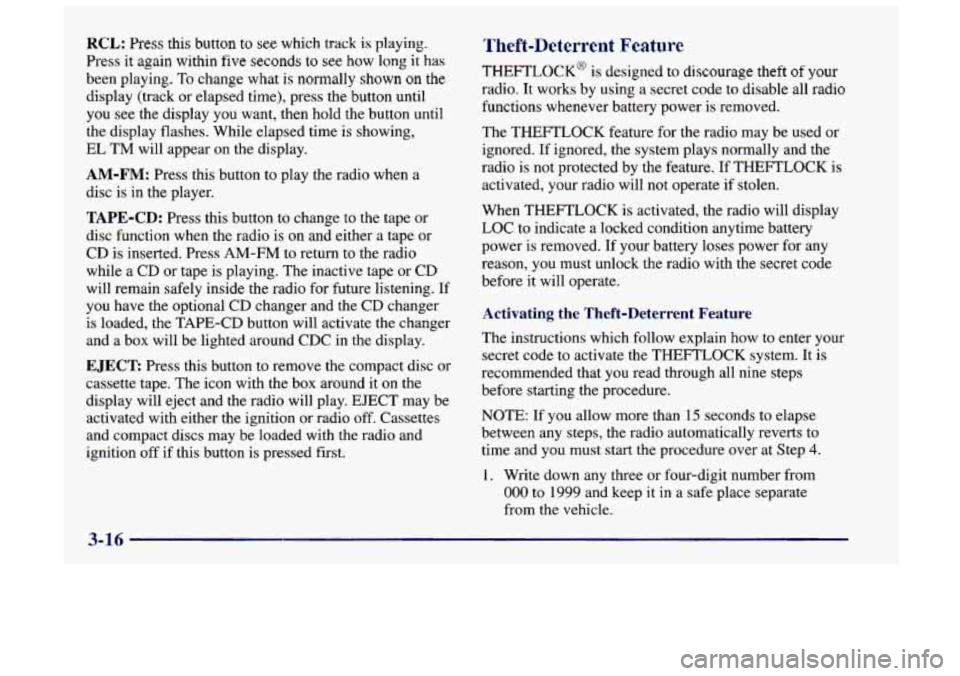
RCL: Press this button to see which track is playing.
Press it again within
five seconds to see how long it has
been playing.
To change what is normally shown on the
display (track or elapsed time), press the button until
you see the display you want, then hold the button until
the display flashes. While elapsed time is showing,
EL
TM will appear on the display.
AM-FM: Press this button to play the radio when a
disc
is in the player.
TAPE-CD: Press this button to change to the tape or
disc function when the radio is on and either a tape or
CD is inserted. Press AM-FM to return to the radio
while a CD or tape is playing. The inactive tape or CD
will remain safely inside the radio for future listening. If
you have the optional CD changer and the CD changer
is loaded, the TAPE-CD button will activate the changer
and a box will be lighted around CDC in the display.
EJECT Press this button to remove the compact disc or
cassette tape. The icon with the box around it on the
display will eject and the radio will play. EJECT may be
activated with either the ignition or radio off. Cassettes
and compact discs may be loaded with the radio and
ignition
off if this button is pressed first.
Theft-Deterrent Feature
THEFTLOCK@ is designed to discourage theft of your
radio. It works by using a secret code to disable all radio
functions whenever battery power is removed.
The THEFTLOCK feature for the radio may be used or
ignored. If ignored, the system plays normally and the
radio is not protected by the feature. If THEFTLOCK is
activated, your radio will not operate if stolen.
When THEFTLOCK is activated, the radio will display
LOC to indicate a locked condition anytime battery
power is removed.
If your battery loses power for any
reason, you must unlock the radio with the secret code
before it will operate.
Activating the Theft-Deterrent Feature
The instructions which follow explain how to enter your
secret code
to activate the THEFTLOCK system. It is
recommended that you read through all nine steps
before starting the procedure.
NOTE: If you allow more than 15 seconds to elapse
between any steps, the radio automatically reverts to
time and you must start
the procedure over at Step 4.
1. Write down any three or four-digit number from
000 to 1999 and keep it in a safe place separate
from the vehicle.
3-16
Page 141 of 356

2. Turn the ignition to ACCESSORY or RUN.
3. Turn the radio off.
4. Press the 1 and 4 buttons together. Hold them down
until
--- shows on the display. Next you will use the
secret code number which you have written down.
5. Press MN and 000 will appear on the display.
6. Press MN again to make the last two digits agree
with your code.
7. Press HR to make the first one or two digits agree
with your code.
8. Press AM-FM after you have confirmed that the
code matches the secret code you have written down.
The display will show REP to let you know that you
need to repeat Steps
5 through 7 to confirm your
secret code.
9. Press AM-FM and this time the display will show
SEC to let you know that your radio is secure.
Unlocking the Theft-Deterrent Feature After a
Power
Loss
Enter your secret code as follows; pause no more than
15 seconds between steps:
1.
LOC appears when the ignition is on.
2. Press MN and 000 will appear on the display.
3. Press MN again to make the last two digits agree
with your code.
4. Press HR to make the first one or two digits agree
with your code.
5. Press AM-FM after you have confirmed that the
code matches the secret code you have written down.
The display will show SEC, indicating the radio is
now operable and secure.
If you enter the wrong code eight times, INOP will
appear on the display. You will have
to wait an hour
with the ignition on before you can try again. When you
try again, you will only have three chances
to enter the
correct code before INOP appears.
If you lose or forget your code, contact your retailer.
3-17
-~
Page 142 of 356
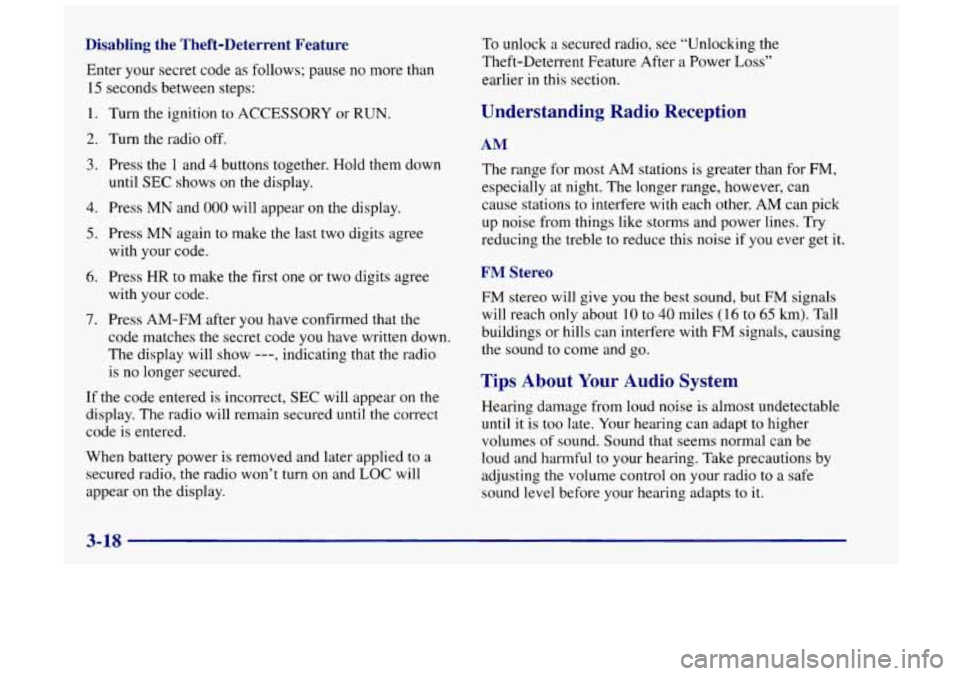
Disabling the Theft-Deterrent Feature
Enter your secret code as follows; pause no more than
15 seconds between steps:
1.
2.
3.
4.
5.
6.
7.
Turn the ignition to ACCESSORY or RUN.
Turn the radio off.
Press the
1 and 4 buttons together. Hold them down
until
SEC shows on the display.
Press
MN and 000 will appear on the display.
Press
MN again to make the last two digits agree
with your code.
Press
HR to make the first one or two digits agree
with your code.
Press AM-FM after you have confirmed that the
code matches the secret code you have written down
The display will show ---, indicating that the radio
is no longer secured.
If the code entered is incorrect,
SEC will appear on the
display. The radio will remain secured until the correct
code is entered.
When battery power is removed and later applied to a
secured radio, the radio won’t turn
on and LOC will
appear
on the display.
To unlock a secured radio, see “Unlocking the
Theft-Deterrent Feature After a Power
Loss”
earlier in this section.
Understanding Radio Reception
AM
The range for most AM stations is greater than for FM,
especially at night. The longer range, however, can
cause stations to interfere with each other. AM can pick
up noise from things like storms and power lines. Try
reducing the treble to reduce this noise
if you ever get it.
FM Stereo
FM stereo will give you the best sound, but FM signals
will reach only about
10 to 40 miles (1 6 to 65 km). Tall
buildings or hills can interfere with FM signals, causing
the sound to come and go.
Tips About Your Audio System
Hearing damage from loud noise is almost undetectable
until
it is too late. Your hearing can adapt to higher
volumes
of sound. Sound that seems normal can be
loud and harmful to your hearing. Take precautions by
adjusting the volume control on your radio to a safe
sound level before your hearing adapts to it.
3-18
Page 172 of 356
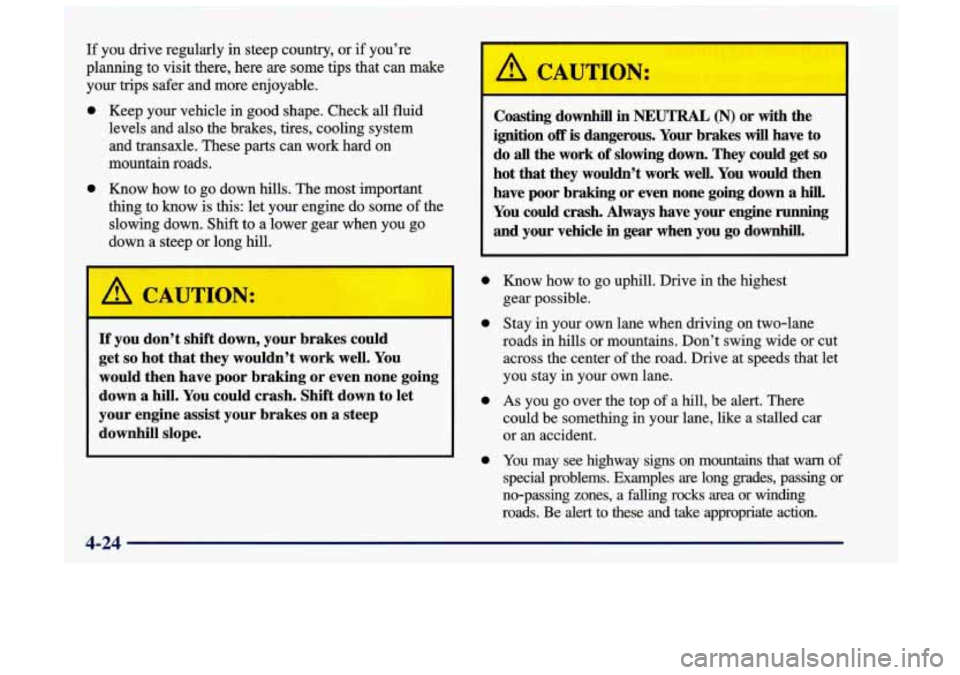
If you drive regularly in steep country, or if you’re
planning to visit there, here
are some tips that can make
your trips safer and more enjoyable.
e Keep your vehicle in good shape. Check all fluid
levels and also the brakes, tires, cooling system
and transaxle. These parts can work hard on
mountain roads.
Know how to go down
hills. The most important
thing to know
is this: let your engine do some of the
slowing down.
Shift to a lower gear when you go
down a steep or long hill.
If you don’t shift down, your brakes could
get
so hot that they wouldn’t work well. You
would then have poor braking or even none going
down
a hill. You could crash. Shift down to let
your engine
assist your brakes on a steep
downhill slope. Coasting downhill
in
NEUTRAL (N) or with the
ignition
off is dangerous. Your brakes will have to
do
all the work of slowing down. They could get so
hot that they wouldn’t work well. You would then
have poor braking
or even none going down a hill.
You could crash. Always have your engine running
and your vehicle in gear when you go downhill.
0
0
Know how to go uphill. Drive in the highest
gear possible.
Stay in your own lane when driving on two-lane
roads in
hills or mountains. Don’t swing wide or cut
across the center
of the road. Drive at speeds that let
you stay in your own lane.
e
0
As you go over the top of a hill, be alert. There
could be something in your lane, like a stalled car
or
an accident.
You may see highway signs on mountains that warn of
special problems. Examples are long grades, passing or
no-passing zones, a falling rocks area or winding
roads. Be alert to these and take appropriate action.
Page 178 of 356
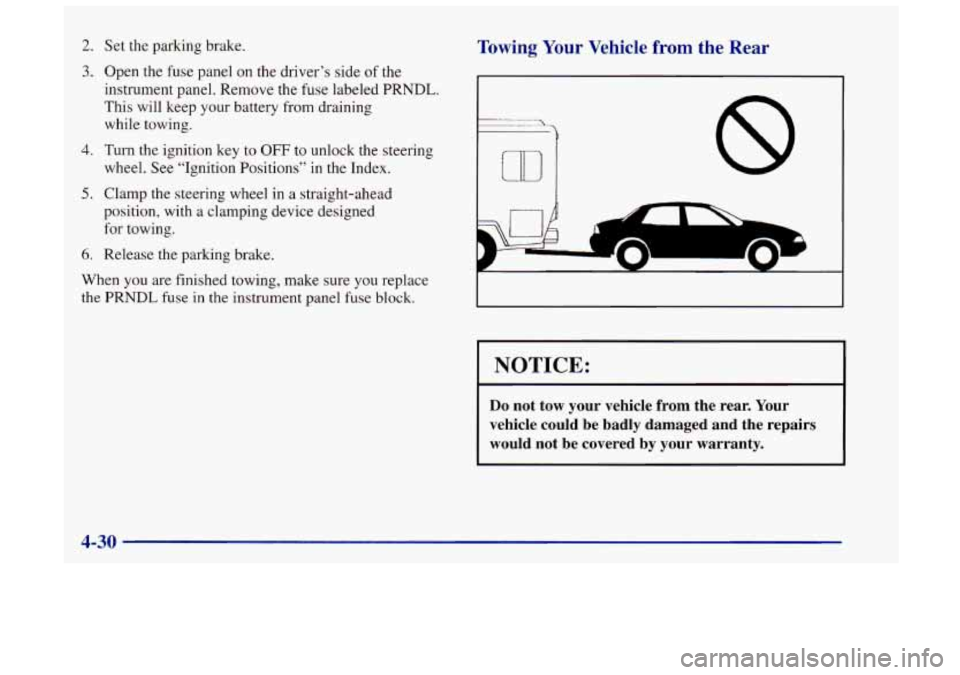
2.
3.
4.
5.
6.
Set the parking brake.
Open the fuse panel
on the driver’s side of the
instrument panel. Remove the fuse labeled
PRNDL.
This will keep your battery from draining
while towing.
Turn the ignition key to
OFF to unlock the steering
wheel. See “Ignition Positions” in the Index.
Clamp the steering wheel in
a straight-ahead
position, with a clamping device designed
for towing.
Release the parking brake.
When you are finished towing, make sure you replace
the
PRNDL fuse in the instrument panel fuse block.
Towing Your Vehicle from the Rear
I NOTICE:
Do not tow your vehicle from the rear. Your
vehicle could be badly damaged and the repairs
would not be covered by your warranty.
4-30
Page 192 of 356
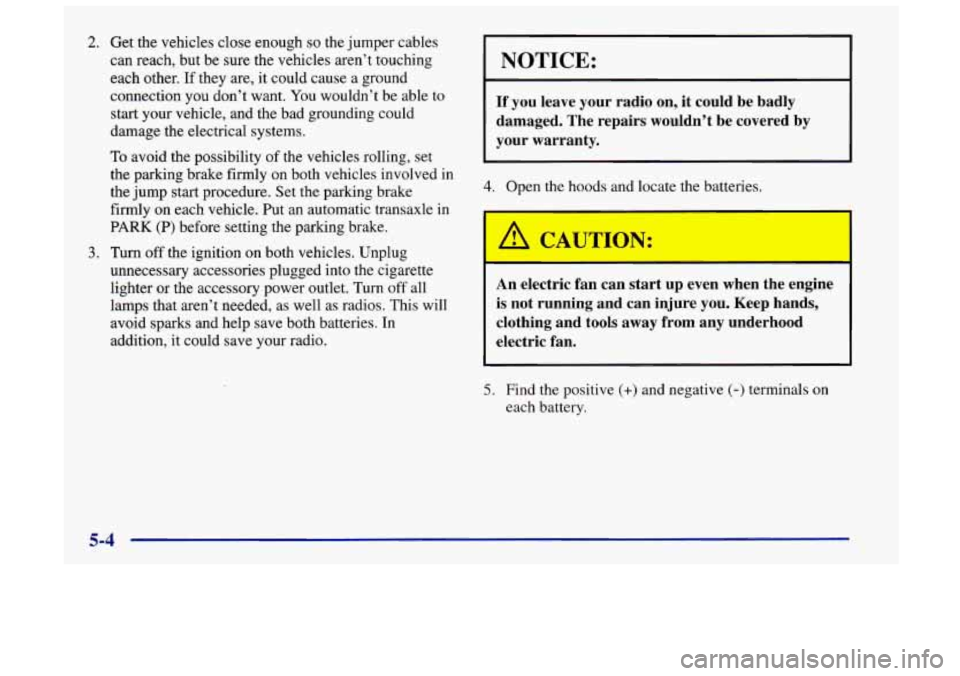
2. Get the vehicles close enough so the jumper cables
can reach, but
be sure the vehicles aren’t touching
each other.
If they are, it could cause a ground
connection you don’t want. You wouldn’t be able to
start your vehicle, and the bad grounding could
damage the electrical systems.
To avoid the possibility of the vehicles rolling, set
the parking brake firmly on both vehicles involved in
the jump start procedure. Set the parking brake
firmly on each vehicle. Put an automatic transaxle in
PARK (P) before setting the parking brake.
3. Turn off the ignition on both vehicles. Unplug
unnecessary accessories plugged into the cigarette
lighter or the accessory power outlet.
Turn off all
lamps that aren’t needed, as well
as radios. This will
avoid
sparks and help save both batteries. In
addition, it could save your radio.
I NOTICE:
If you leave your radio on, it could be badly
damaged. The repairs wouldn’t be covered by
your warranty.
4. Open the hoods and locate the batteries.
CAUTION:
An electric fan can start up even when the engine
is not running and can injure you. Keep hands,
clothing and tools away from any underhood
electric fan.
5. Find the positive (+) and negative (-) terminals on
each battery.
5-4
Page 198 of 356
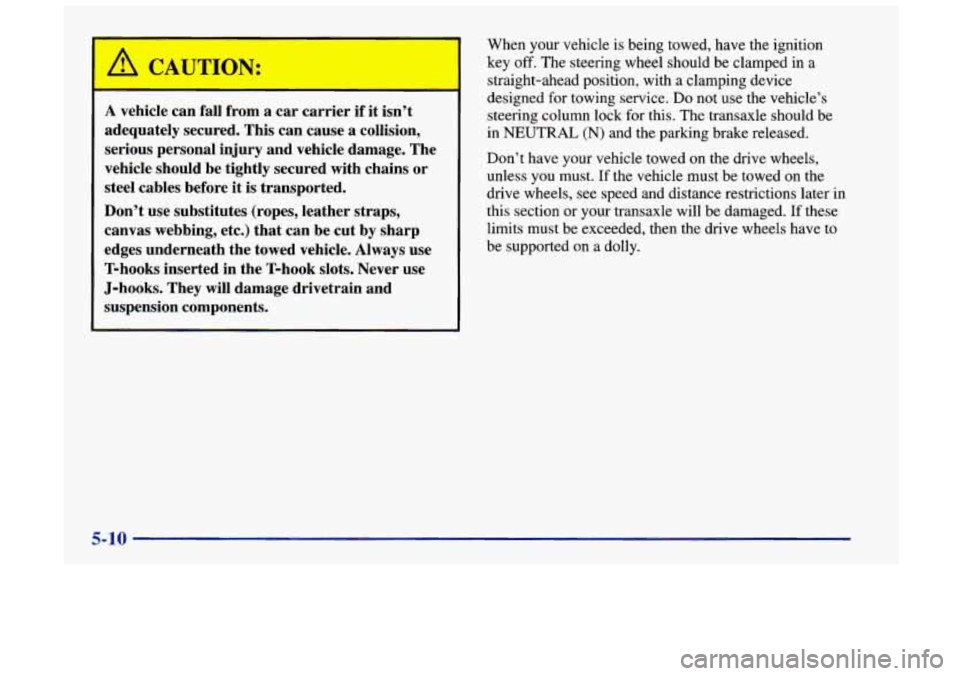
!L CAUTION:
A vehicle can fall from a car carrier if it isn’t
adequately secured. This can cause a collision,
serious personal injury and vehicle damage. The
vehicle should be tightly secured with chains or
steel cables before it is transported.
Don’t use substitutes (ropes, leather straps,
canvas webbing, etc.) that can be cut by sharp
edges underneath the towed vehicle. Always use
T-hooks inserted in the T-hook slots. Never use
J-hooks. They will damage drivetrain and
suspension components.
When your vehicle is being towed, have the ignition
key off. The steering wheel should be clamped
in a
straight-ahead position, with
a clamping device
designed for towing service. Do not use the vehicle’s
steering column lock for this. The transaxle should be
in
NEUTRAL (N) and the parking brake released.
Don’t have your vehicle towed on the drive wheels,
unless you must. If the vehicle must be towed on the
drive wheels, see speed and distance restrictions later
in
this section or your transaxle will be damaged. If these
limits must be exceeded, then the drive wheels have to
be supported on a dolly.
5-10
-
Page 202 of 356

NOTICE:
Do not have your vehicle towed with the front
wheels in contact with the ground. This will
damage the transaxle. If the vehicle must be
towed on the front wheels, it cannot be towed
more than a total of
500 miles (800km) for the
lifetime of the vehicle.
NOTE: The ignition must be in the OFF position to keep
automatic door locks from locking during
tow.
Attach T-hook chains on
both sides in the slotted
holes in the bottom of the
frame rail just ahead of the
These slots are
to be used when loading and securing to
car-carrier equipment.
Attach
a separate safety
chain to each side
of the
axle inboard
of the spring.
5-14
Page 284 of 356
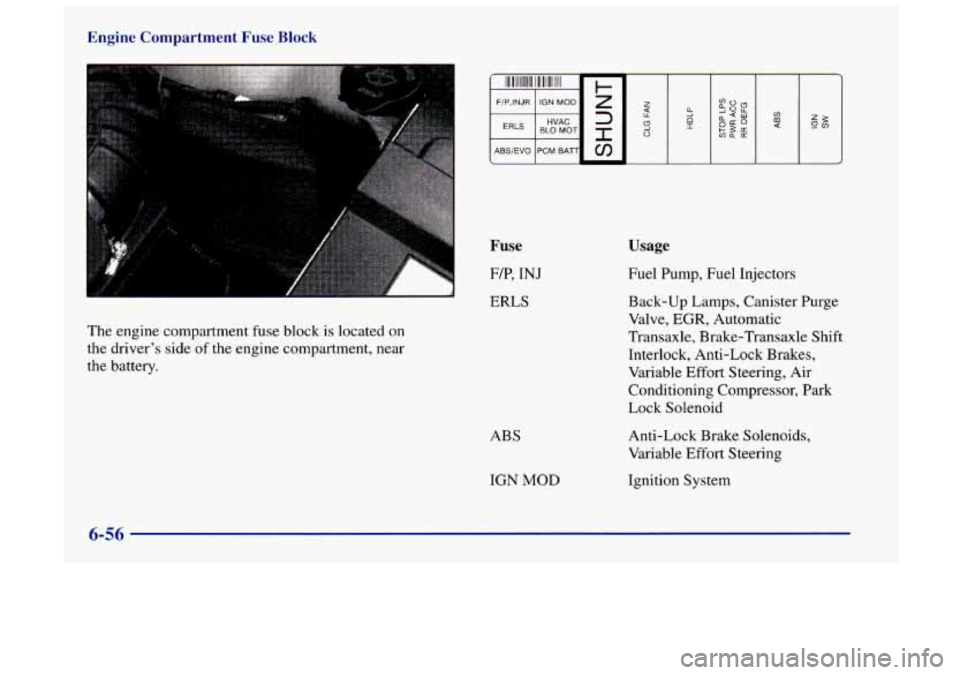
Engine Compartment Fuse Block
I
Fuse
FP,
INJ
ERLS
The engine compartment fuse block
is located on
the driver’s side of the engine compartment, near
the battery.
ABS
IGN
MOD
Usage
Fuel Pump, Fuel Injectors
Back-up Lamps, Canister Purge
Valve,
EGR, Automatic
Transaxle, Brake-Transaxle Shift
Interlock, Anti-Lock Brakes,
Variable
Effort Steering, Air
Conditioning Compressor, Park
Lock Solenoid
Anti-Lock Brake Solenoids,
Variable
Effort Steering
Ignition System
6-56
Page 285 of 356
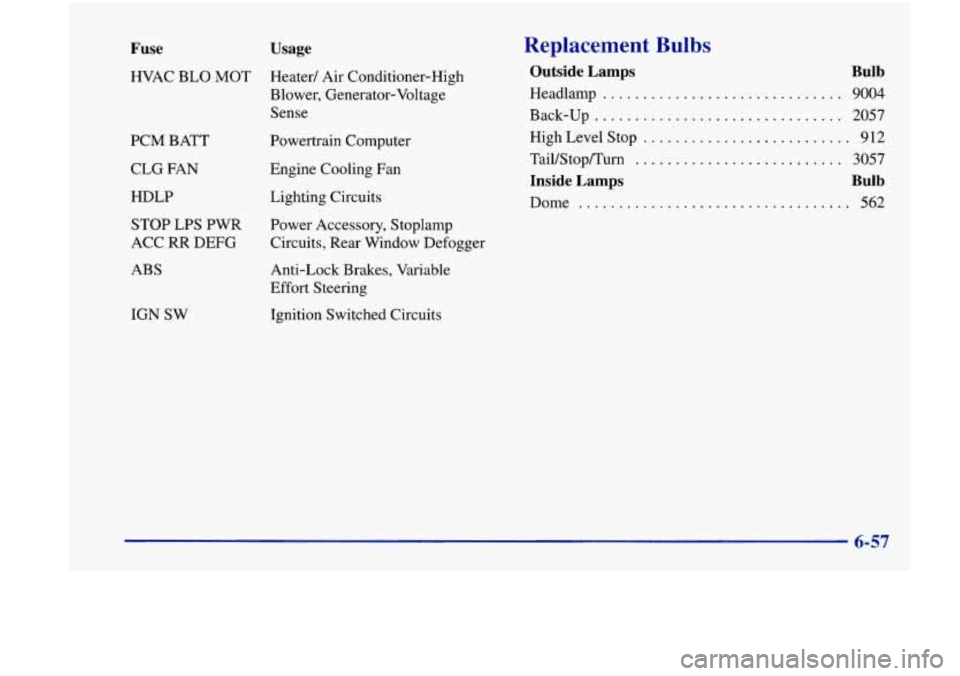
Fuse Usage
HVAC BLO MOT Heater/ Air Conditioner-High
Blower, Generator-Voltage
Sense
PCM BATT
CLG
FAN
HDLP STOP LPS PWR
ACC
RR DEFG
ABS
IGN SW Powertrain Computer
Engine Cooling Fan
Lighting Circuits
Power
Accessory, Stoplamp
Circuits, Rear Window Defogger
Anti-Lock Brakes, Variable
Effort Steering
Ignition Switched Circuits
Replacement Bulbs
Outside Lamps Bulb
Headlamp .............................. 9004
Back-up
............................... 2057
High Level Stop .......................... 912
Tail/Stop/Turn
.......................... 3057
Inside Lamps Bulb
Dome .................................. 562